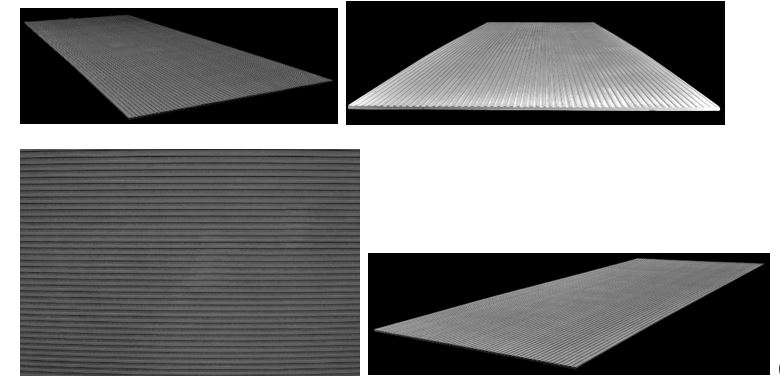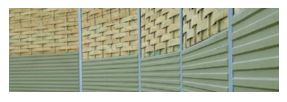Contact
January 26, 2022
Facts
The Belgian company Eternit owns the following Community registered design in Class 25.01 covering “Panels [building]”:

(the CRD).
The CRD was filed in September 2014.
In December 2016, Eternit Österreich GmbH (EOG) applied for a declaration of invalidity of the CRD, which was duly granted on the ground that it lacked individual character in relation to an earlier design disclosed in a brochure for noise reduction wall panels in March 2013, represented as follows:

Eternit appealed and the Third Board of Appeal upheld the Cancellation Division’s original decision.
Eternit appealed to the General Court, alleging that the BoA had erred in its assessment of overall impression by wrongly: (i) defining the relevant sector and the informed user; (ii) determining the designer’s degree of freedom in the sector; and (iii) concluding that there was no difference in the overall impression produced by the CRD and the earlier design.
Decision
The GC noted that the assessment of individual character is a four-stage examination. The first three stages, i.e., the sector, the informed user and the designer’s degree of freedom, involve an examination of the contested design only, but the fourth stage, i.e., overall impression, requires both the contested design and the earlier design to be considered.
The sector, informed user and design freedom
Eternit said that the correct definition of the relevant sector was “façade panels for buildings” and that the BoA had been wrong to define the sector as “building panels”.
The GC disagreed, finding that, first, Eternit’s own description of the CRD, as indicated in the filing application form, was “panels [building]”. Eternit had therefore not chosen to limit the registration to “façade panels for buildings”. Secondly, the representations of the CRD did not show the nature of the product in which the design was intended to be incorporated or to which it was to be applied, nor did it show its intended purpose of function. There was nothing to indicate that it was intended to be applied solely to façade panels for buildings, to the exclusion of any other building panel.
As for the informed user, Eternit argued that it ought to be the user of “façade panels for buildings”, which the GC rejected for the same reasons as for the definition of the sector. The BoA was entitled to find that the informed user was a professional in the construction sector, for example a constructor, a real estate developer or an architect, who had some knowledge of the various building panels and displayed a high level of attention.
The BoA had found that the designer’s freedom in developing building panels was limited to a certain degree by the fact that they fulfilled a technical function (i.e., providing weather resistance, acoustic properties, fire resistance and structural properties), since they had to be safely fixed to the wall, façade or roof, and because they had to enhance the aesthetics of a building. However, the BoA had also found that the designer had a considerable degree of freedom in relation to surface types, shapes, colours and patterns. Therefore, the BoA had concluded that the common features of the designs included elements in which the designer enjoyed an average degree of freedom.
Eternit said that the designer’s freedom had to be assessed in relation to the “façade panels for buildings” sector and that the CRD was largely dictated by the functions of the panels. It said that the functions impacted on the design of the surface of the panels, which necessarily had to be flat and contain a play of lines and colour. Since the number of colours and patterns was limited, the designer’s freedom was not unlimited or considerable, it said. Therefore, the freedom enjoyed by the designer of façade panels for buildings was, at best, average.
The GC rejected Eternit’s arguments, finding that the BoA had been correct to assess the freedom of the designer of “building panels” and not of “façade panels for buildings” for the same reasons as above. In any event, both Eternit and the BoA had concluded that the designer’s freedom was average. Further, Eternit had not shown that such panels had to use linear designs in the form of ridges and valleys or that certain colours had to be used to the exclusion of other shapes or colours. In fact, these elements did not restrict the designer, but provided freedom to discover new shapes and trends.
Overall impression
The GC noted that, in certain circumstances, when assessing individual character, the goods to which the designs are applied can be considered. However, this is only permitted for illustrative purposes and the goods must correspond to the design as registered. Therefore, if the graphic or photographic representation of the design does not, on its own, make clear its visible aspects or how it would be perceived, it is permissible to consider the products as marketed or the way in which they are used.
The GC noted that there were similarities and differences between the CRD and the earlier design but said that Eternit’s emphasis on proportions and dimensions was irrelevant as the protection of a registered design relates to the overall design, not to the actual dimensions of the products to which the design relates.
In any event, the GC said, the informed user would not pay particular attention to the exact ratios between the ridges and the valleys or to the degree of the various angles. Rather, the user would pay attention to the overall shape of the designs and their common features which, taken as a whole, gave an impression of similarity, namely a flat linear surface defined by a visually similar sequence of ridges and valleys, with a similar structure and ratios, which, although different, were not capable of preventing any impression of déjà vu.
Considering the actual product as marketed and used, the GC noted that the designs would usually be looked at from a distance, whether they were applied to buildings or walls. Consequently, any differences in the number of lines and in the proportion of the dimensions of the ridges or protuberances played only a minor role in the overall impressions created.
The GC also rejected Eternit’s argument that the different colour used in the earlier design altered the overall impression created. The CRD was represented in black and white, and no colour was claimed in the application. Therefore, any colour used in the earlier design was irrelevant.
Accordingly, the BoA had not erred in its assessment of individual character and the appeal was dismissed. (Case T-193/20 Eternit v EUIPO EU:T:2021:782 (10 November 2021) — to read the judgment in full, click here).
Expertise